Risk Management and Operations Improvement Strategy Implementation
VerifiedAdded on 2023/06/05
|11
|3950
|425
Report
AI Summary
This report discusses the implementation of risk management strategies and operations improvement techniques within a business context, focusing on Toyota as an example. It highlights the importance of risk management for identifying and mitigating potential threats such as natural disasters and quality issues. The report outlines a risk management process involving risk identification, assessment, response development, and preventive mechanisms. It explores various risk management strategies, including risk acceptance and risk reduction, and their application to specific business challenges. Furthermore, the report emphasizes the significance of operations improvement, particularly in challenging times, and suggests strategies such as automation and customer-centric approaches. It also details operational management techniques like Just-in-Time (JIT) inventory and supply chain management to enhance efficiency, reduce waste, and improve market competitiveness. The report concludes by advocating for a combined approach of risk management and operational improvements to ensure business continuity, protect assets, and enhance customer satisfaction.
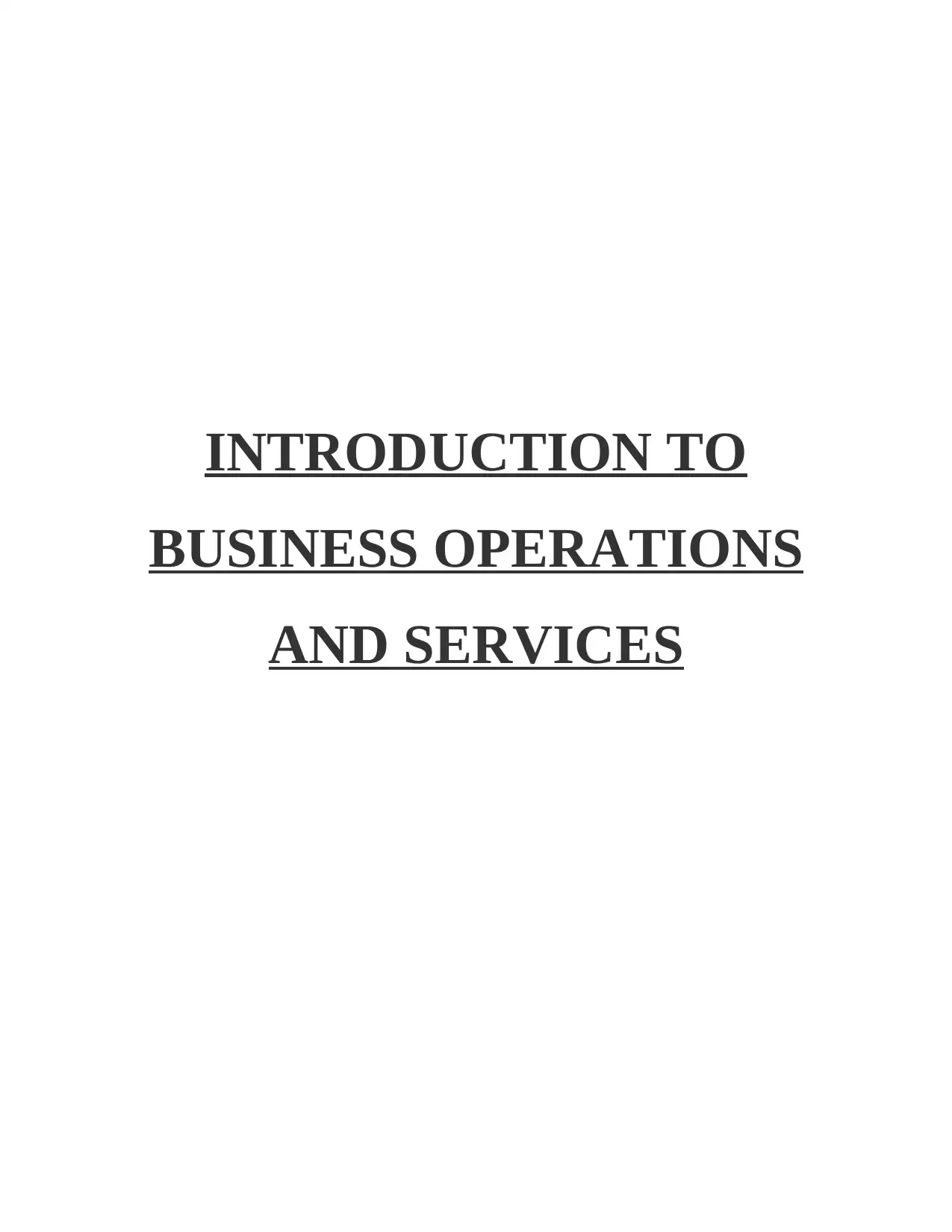
INTRODUCTION TO
BUSINESS OPERATIONS
AND SERVICES
BUSINESS OPERATIONS
AND SERVICES
Paraphrase This Document
Need a fresh take? Get an instant paraphrase of this document with our AI Paraphraser
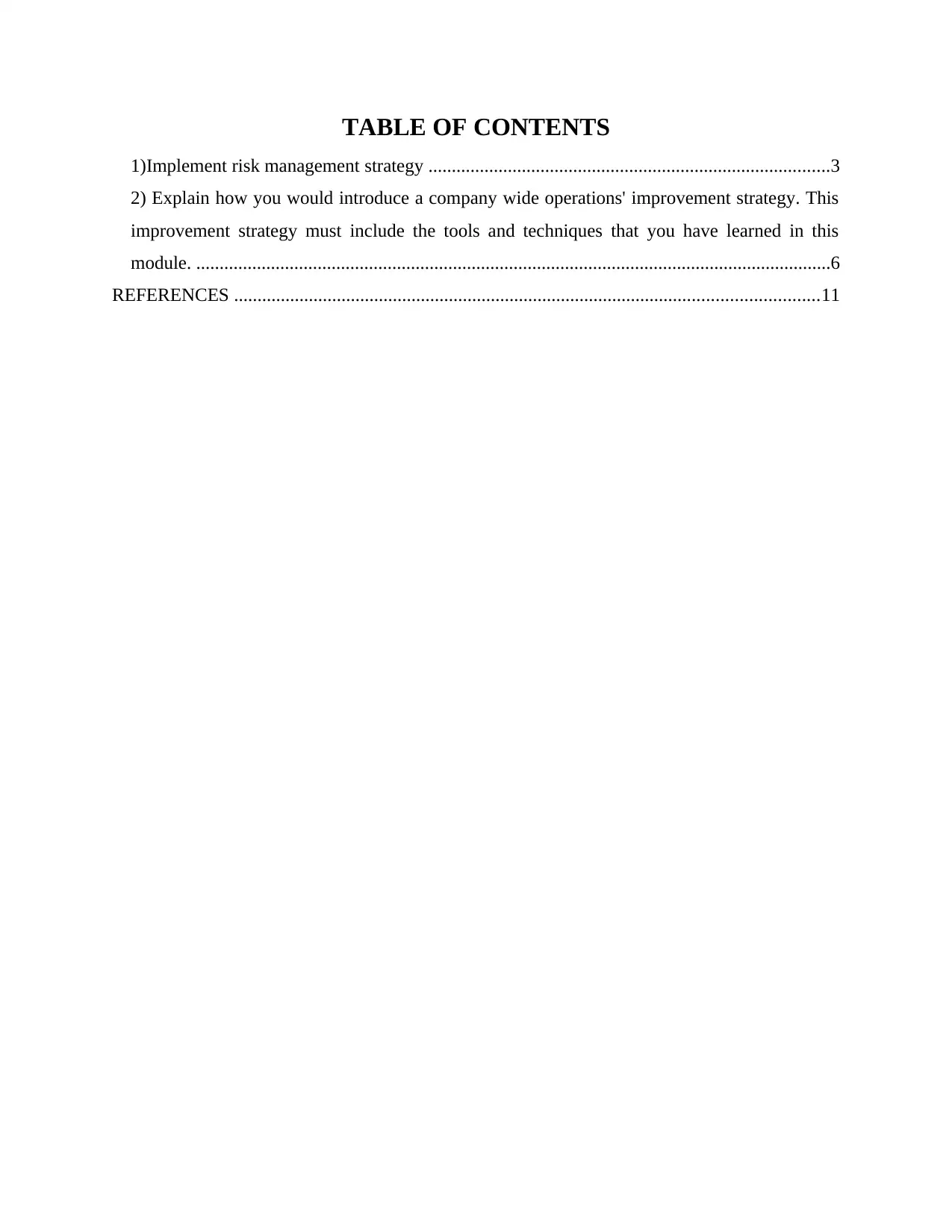
TABLE OF CONTENTS
1)Implement risk management strategy ......................................................................................3
2) Explain how you would introduce a company wide operations' improvement strategy. This
improvement strategy must include the tools and techniques that you have learned in this
module. ........................................................................................................................................6
REFERENCES .............................................................................................................................11
1)Implement risk management strategy ......................................................................................3
2) Explain how you would introduce a company wide operations' improvement strategy. This
improvement strategy must include the tools and techniques that you have learned in this
module. ........................................................................................................................................6
REFERENCES .............................................................................................................................11
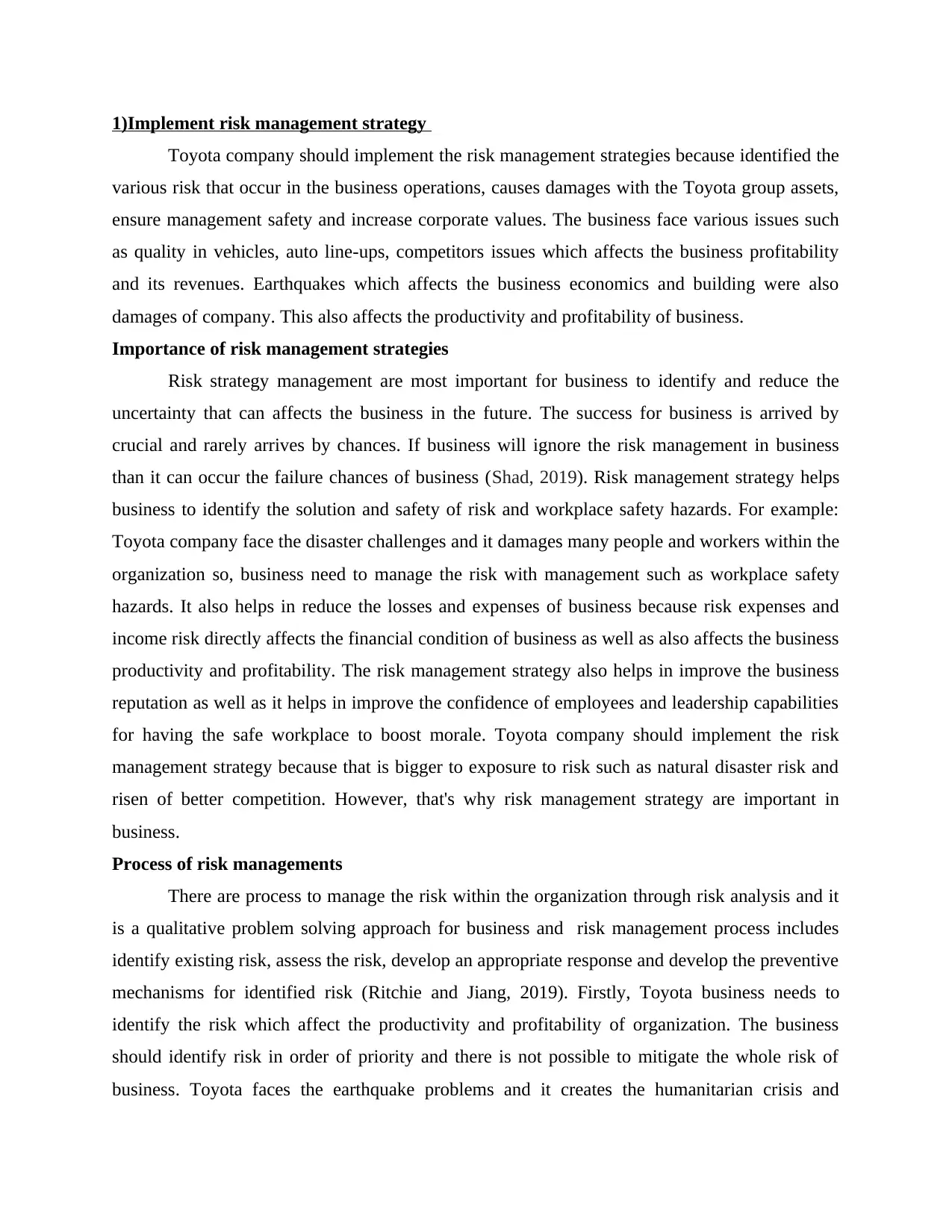
1)Implement risk management strategy
Toyota company should implement the risk management strategies because identified the
various risk that occur in the business operations, causes damages with the Toyota group assets,
ensure management safety and increase corporate values. The business face various issues such
as quality in vehicles, auto line-ups, competitors issues which affects the business profitability
and its revenues. Earthquakes which affects the business economics and building were also
damages of company. This also affects the productivity and profitability of business.
Importance of risk management strategies
Risk strategy management are most important for business to identify and reduce the
uncertainty that can affects the business in the future. The success for business is arrived by
crucial and rarely arrives by chances. If business will ignore the risk management in business
than it can occur the failure chances of business (Shad, 2019). Risk management strategy helps
business to identify the solution and safety of risk and workplace safety hazards. For example:
Toyota company face the disaster challenges and it damages many people and workers within the
organization so, business need to manage the risk with management such as workplace safety
hazards. It also helps in reduce the losses and expenses of business because risk expenses and
income risk directly affects the financial condition of business as well as also affects the business
productivity and profitability. The risk management strategy also helps in improve the business
reputation as well as it helps in improve the confidence of employees and leadership capabilities
for having the safe workplace to boost morale. Toyota company should implement the risk
management strategy because that is bigger to exposure to risk such as natural disaster risk and
risen of better competition. However, that's why risk management strategy are important in
business.
Process of risk managements
There are process to manage the risk within the organization through risk analysis and it
is a qualitative problem solving approach for business and risk management process includes
identify existing risk, assess the risk, develop an appropriate response and develop the preventive
mechanisms for identified risk (Ritchie and Jiang, 2019). Firstly, Toyota business needs to
identify the risk which affect the productivity and profitability of organization. The business
should identify risk in order of priority and there is not possible to mitigate the whole risk of
business. Toyota faces the earthquake problems and it creates the humanitarian crisis and
Toyota company should implement the risk management strategies because identified the
various risk that occur in the business operations, causes damages with the Toyota group assets,
ensure management safety and increase corporate values. The business face various issues such
as quality in vehicles, auto line-ups, competitors issues which affects the business profitability
and its revenues. Earthquakes which affects the business economics and building were also
damages of company. This also affects the productivity and profitability of business.
Importance of risk management strategies
Risk strategy management are most important for business to identify and reduce the
uncertainty that can affects the business in the future. The success for business is arrived by
crucial and rarely arrives by chances. If business will ignore the risk management in business
than it can occur the failure chances of business (Shad, 2019). Risk management strategy helps
business to identify the solution and safety of risk and workplace safety hazards. For example:
Toyota company face the disaster challenges and it damages many people and workers within the
organization so, business need to manage the risk with management such as workplace safety
hazards. It also helps in reduce the losses and expenses of business because risk expenses and
income risk directly affects the financial condition of business as well as also affects the business
productivity and profitability. The risk management strategy also helps in improve the business
reputation as well as it helps in improve the confidence of employees and leadership capabilities
for having the safe workplace to boost morale. Toyota company should implement the risk
management strategy because that is bigger to exposure to risk such as natural disaster risk and
risen of better competition. However, that's why risk management strategy are important in
business.
Process of risk managements
There are process to manage the risk within the organization through risk analysis and it
is a qualitative problem solving approach for business and risk management process includes
identify existing risk, assess the risk, develop an appropriate response and develop the preventive
mechanisms for identified risk (Ritchie and Jiang, 2019). Firstly, Toyota business needs to
identify the risk which affect the productivity and profitability of organization. The business
should identify risk in order of priority and there is not possible to mitigate the whole risk of
business. Toyota faces the earthquake problems and it creates the humanitarian crisis and
⊘ This is a preview!⊘
Do you want full access?
Subscribe today to unlock all pages.

Trusted by 1+ million students worldwide
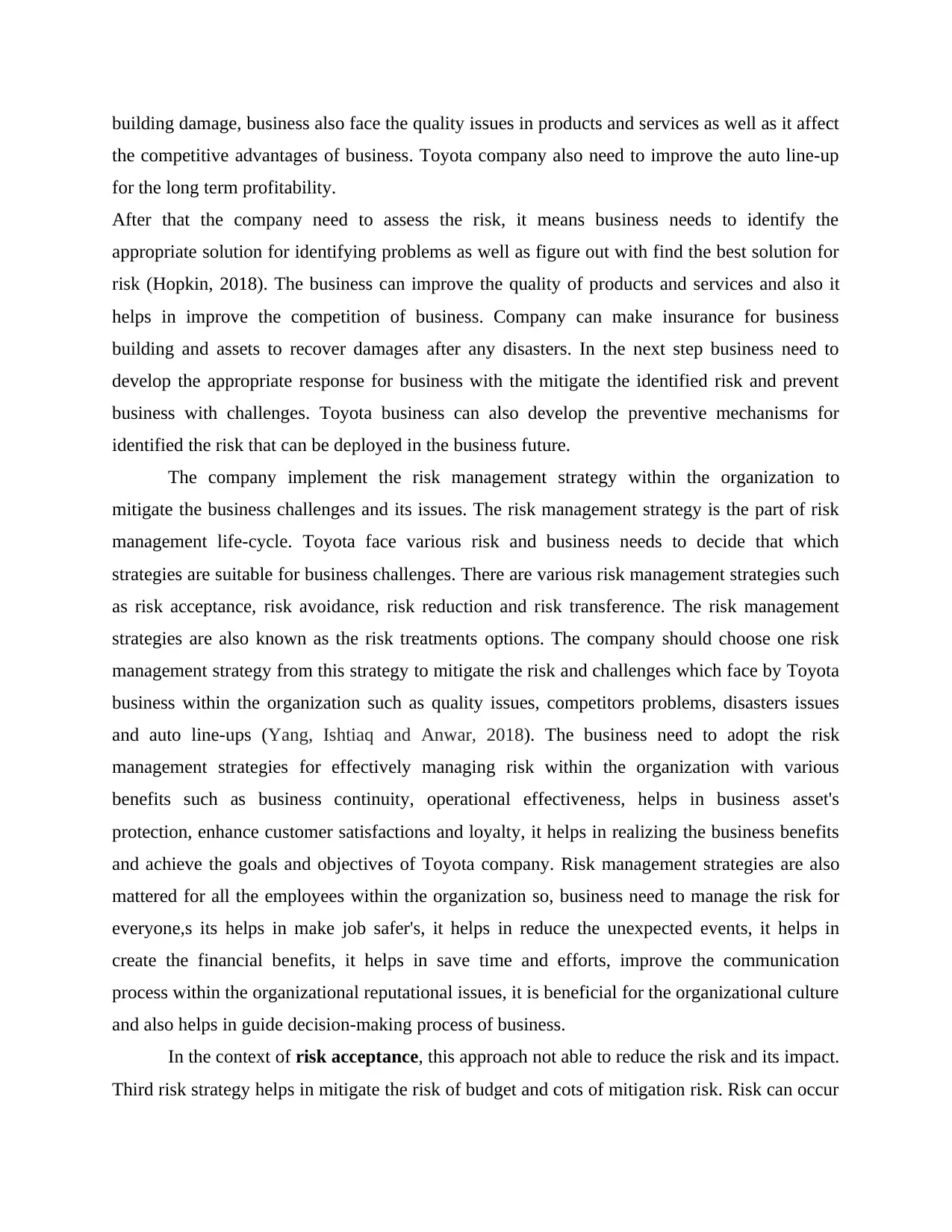
building damage, business also face the quality issues in products and services as well as it affect
the competitive advantages of business. Toyota company also need to improve the auto line-up
for the long term profitability.
After that the company need to assess the risk, it means business needs to identify the
appropriate solution for identifying problems as well as figure out with find the best solution for
risk (Hopkin, 2018). The business can improve the quality of products and services and also it
helps in improve the competition of business. Company can make insurance for business
building and assets to recover damages after any disasters. In the next step business need to
develop the appropriate response for business with the mitigate the identified risk and prevent
business with challenges. Toyota business can also develop the preventive mechanisms for
identified the risk that can be deployed in the business future.
The company implement the risk management strategy within the organization to
mitigate the business challenges and its issues. The risk management strategy is the part of risk
management life-cycle. Toyota face various risk and business needs to decide that which
strategies are suitable for business challenges. There are various risk management strategies such
as risk acceptance, risk avoidance, risk reduction and risk transference. The risk management
strategies are also known as the risk treatments options. The company should choose one risk
management strategy from this strategy to mitigate the risk and challenges which face by Toyota
business within the organization such as quality issues, competitors problems, disasters issues
and auto line-ups (Yang, Ishtiaq and Anwar, 2018). The business need to adopt the risk
management strategies for effectively managing risk within the organization with various
benefits such as business continuity, operational effectiveness, helps in business asset's
protection, enhance customer satisfactions and loyalty, it helps in realizing the business benefits
and achieve the goals and objectives of Toyota company. Risk management strategies are also
mattered for all the employees within the organization so, business need to manage the risk for
everyone,s its helps in make job safer's, it helps in reduce the unexpected events, it helps in
create the financial benefits, it helps in save time and efforts, improve the communication
process within the organizational reputational issues, it is beneficial for the organizational culture
and also helps in guide decision-making process of business.
In the context of risk acceptance, this approach not able to reduce the risk and its impact.
Third risk strategy helps in mitigate the risk of budget and cots of mitigation risk. Risk can occur
the competitive advantages of business. Toyota company also need to improve the auto line-up
for the long term profitability.
After that the company need to assess the risk, it means business needs to identify the
appropriate solution for identifying problems as well as figure out with find the best solution for
risk (Hopkin, 2018). The business can improve the quality of products and services and also it
helps in improve the competition of business. Company can make insurance for business
building and assets to recover damages after any disasters. In the next step business need to
develop the appropriate response for business with the mitigate the identified risk and prevent
business with challenges. Toyota business can also develop the preventive mechanisms for
identified the risk that can be deployed in the business future.
The company implement the risk management strategy within the organization to
mitigate the business challenges and its issues. The risk management strategy is the part of risk
management life-cycle. Toyota face various risk and business needs to decide that which
strategies are suitable for business challenges. There are various risk management strategies such
as risk acceptance, risk avoidance, risk reduction and risk transference. The risk management
strategies are also known as the risk treatments options. The company should choose one risk
management strategy from this strategy to mitigate the risk and challenges which face by Toyota
business within the organization such as quality issues, competitors problems, disasters issues
and auto line-ups (Yang, Ishtiaq and Anwar, 2018). The business need to adopt the risk
management strategies for effectively managing risk within the organization with various
benefits such as business continuity, operational effectiveness, helps in business asset's
protection, enhance customer satisfactions and loyalty, it helps in realizing the business benefits
and achieve the goals and objectives of Toyota company. Risk management strategies are also
mattered for all the employees within the organization so, business need to manage the risk for
everyone,s its helps in make job safer's, it helps in reduce the unexpected events, it helps in
create the financial benefits, it helps in save time and efforts, improve the communication
process within the organizational reputational issues, it is beneficial for the organizational culture
and also helps in guide decision-making process of business.
In the context of risk acceptance, this approach not able to reduce the risk and its impact.
Third risk strategy helps in mitigate the risk of budget and cots of mitigation risk. Risk can occur
Paraphrase This Document
Need a fresh take? Get an instant paraphrase of this document with our AI Paraphraser
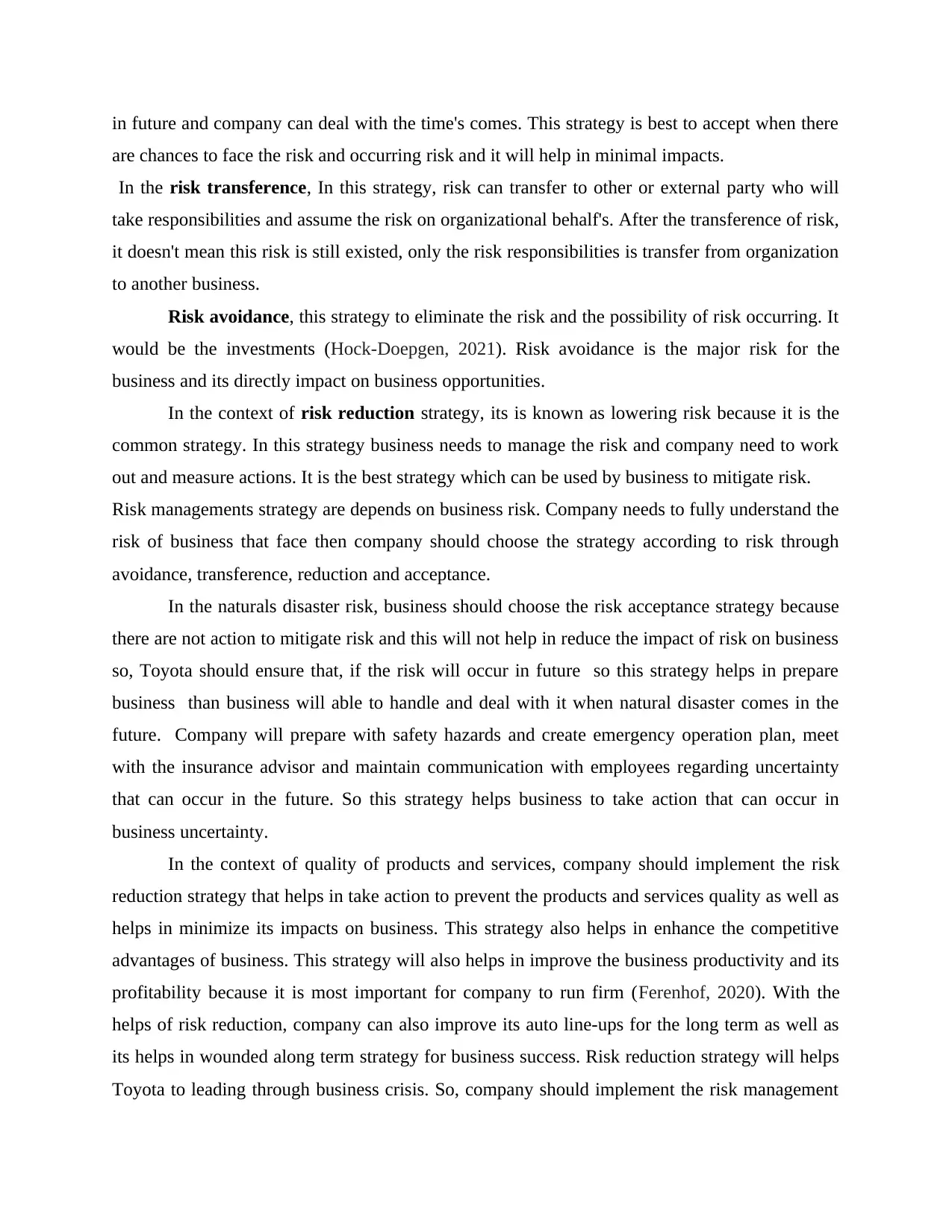
in future and company can deal with the time's comes. This strategy is best to accept when there
are chances to face the risk and occurring risk and it will help in minimal impacts.
In the risk transference, In this strategy, risk can transfer to other or external party who will
take responsibilities and assume the risk on organizational behalf's. After the transference of risk,
it doesn't mean this risk is still existed, only the risk responsibilities is transfer from organization
to another business.
Risk avoidance, this strategy to eliminate the risk and the possibility of risk occurring. It
would be the investments (Hock-Doepgen, 2021). Risk avoidance is the major risk for the
business and its directly impact on business opportunities.
In the context of risk reduction strategy, its is known as lowering risk because it is the
common strategy. In this strategy business needs to manage the risk and company need to work
out and measure actions. It is the best strategy which can be used by business to mitigate risk.
Risk managements strategy are depends on business risk. Company needs to fully understand the
risk of business that face then company should choose the strategy according to risk through
avoidance, transference, reduction and acceptance.
In the naturals disaster risk, business should choose the risk acceptance strategy because
there are not action to mitigate risk and this will not help in reduce the impact of risk on business
so, Toyota should ensure that, if the risk will occur in future so this strategy helps in prepare
business than business will able to handle and deal with it when natural disaster comes in the
future. Company will prepare with safety hazards and create emergency operation plan, meet
with the insurance advisor and maintain communication with employees regarding uncertainty
that can occur in the future. So this strategy helps business to take action that can occur in
business uncertainty.
In the context of quality of products and services, company should implement the risk
reduction strategy that helps in take action to prevent the products and services quality as well as
helps in minimize its impacts on business. This strategy also helps in enhance the competitive
advantages of business. This strategy will also helps in improve the business productivity and its
profitability because it is most important for company to run firm (Ferenhof, 2020). With the
helps of risk reduction, company can also improve its auto line-ups for the long term as well as
its helps in wounded along term strategy for business success. Risk reduction strategy will helps
Toyota to leading through business crisis. So, company should implement the risk management
are chances to face the risk and occurring risk and it will help in minimal impacts.
In the risk transference, In this strategy, risk can transfer to other or external party who will
take responsibilities and assume the risk on organizational behalf's. After the transference of risk,
it doesn't mean this risk is still existed, only the risk responsibilities is transfer from organization
to another business.
Risk avoidance, this strategy to eliminate the risk and the possibility of risk occurring. It
would be the investments (Hock-Doepgen, 2021). Risk avoidance is the major risk for the
business and its directly impact on business opportunities.
In the context of risk reduction strategy, its is known as lowering risk because it is the
common strategy. In this strategy business needs to manage the risk and company need to work
out and measure actions. It is the best strategy which can be used by business to mitigate risk.
Risk managements strategy are depends on business risk. Company needs to fully understand the
risk of business that face then company should choose the strategy according to risk through
avoidance, transference, reduction and acceptance.
In the naturals disaster risk, business should choose the risk acceptance strategy because
there are not action to mitigate risk and this will not help in reduce the impact of risk on business
so, Toyota should ensure that, if the risk will occur in future so this strategy helps in prepare
business than business will able to handle and deal with it when natural disaster comes in the
future. Company will prepare with safety hazards and create emergency operation plan, meet
with the insurance advisor and maintain communication with employees regarding uncertainty
that can occur in the future. So this strategy helps business to take action that can occur in
business uncertainty.
In the context of quality of products and services, company should implement the risk
reduction strategy that helps in take action to prevent the products and services quality as well as
helps in minimize its impacts on business. This strategy also helps in enhance the competitive
advantages of business. This strategy will also helps in improve the business productivity and its
profitability because it is most important for company to run firm (Ferenhof, 2020). With the
helps of risk reduction, company can also improve its auto line-ups for the long term as well as
its helps in wounded along term strategy for business success. Risk reduction strategy will helps
Toyota to leading through business crisis. So, company should implement the risk management
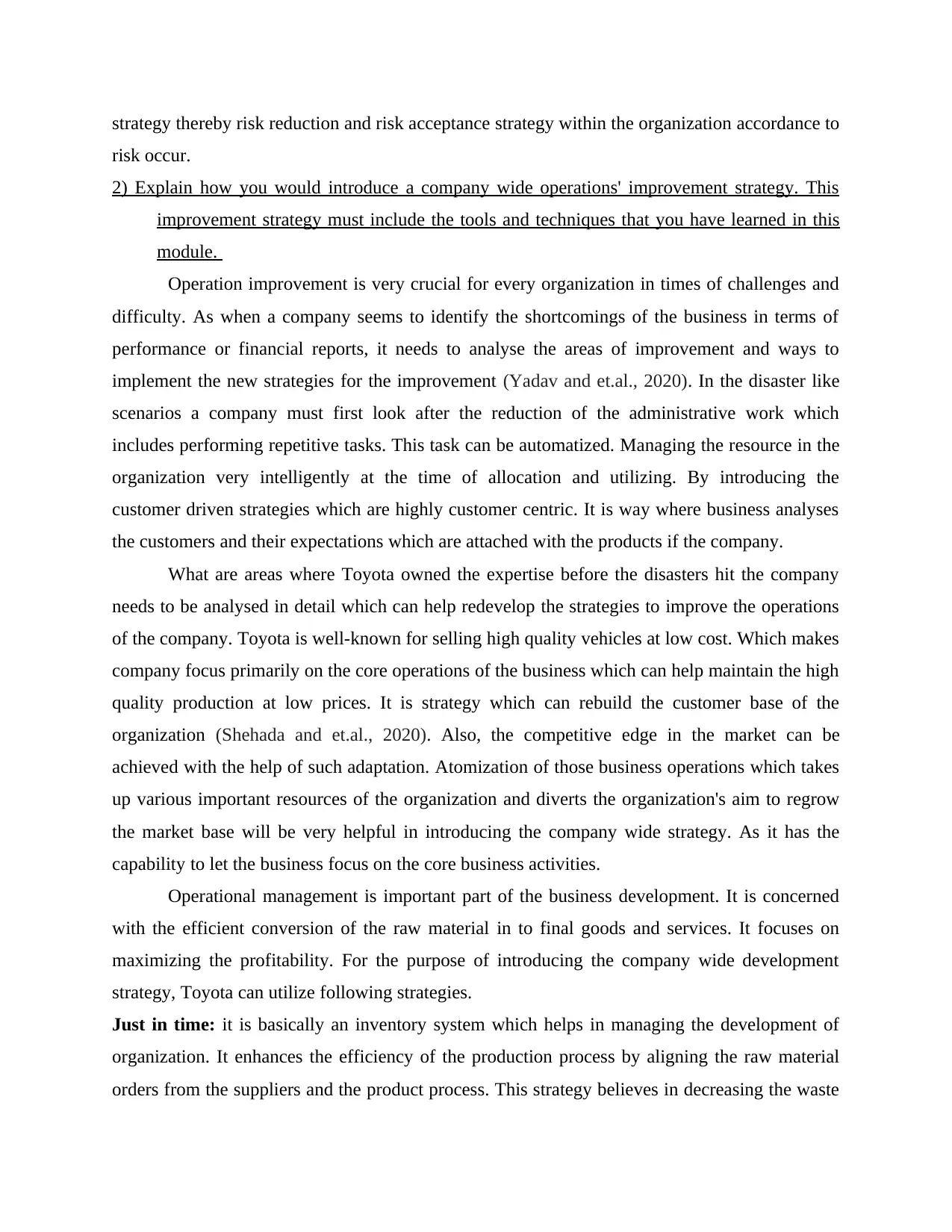
strategy thereby risk reduction and risk acceptance strategy within the organization accordance to
risk occur.
2) Explain how you would introduce a company wide operations' improvement strategy. This
improvement strategy must include the tools and techniques that you have learned in this
module.
Operation improvement is very crucial for every organization in times of challenges and
difficulty. As when a company seems to identify the shortcomings of the business in terms of
performance or financial reports, it needs to analyse the areas of improvement and ways to
implement the new strategies for the improvement (Yadav and et.al., 2020). In the disaster like
scenarios a company must first look after the reduction of the administrative work which
includes performing repetitive tasks. This task can be automatized. Managing the resource in the
organization very intelligently at the time of allocation and utilizing. By introducing the
customer driven strategies which are highly customer centric. It is way where business analyses
the customers and their expectations which are attached with the products if the company.
What are areas where Toyota owned the expertise before the disasters hit the company
needs to be analysed in detail which can help redevelop the strategies to improve the operations
of the company. Toyota is well-known for selling high quality vehicles at low cost. Which makes
company focus primarily on the core operations of the business which can help maintain the high
quality production at low prices. It is strategy which can rebuild the customer base of the
organization (Shehada and et.al., 2020). Also, the competitive edge in the market can be
achieved with the help of such adaptation. Atomization of those business operations which takes
up various important resources of the organization and diverts the organization's aim to regrow
the market base will be very helpful in introducing the company wide strategy. As it has the
capability to let the business focus on the core business activities.
Operational management is important part of the business development. It is concerned
with the efficient conversion of the raw material in to final goods and services. It focuses on
maximizing the profitability. For the purpose of introducing the company wide development
strategy, Toyota can utilize following strategies.
Just in time: it is basically an inventory system which helps in managing the development of
organization. It enhances the efficiency of the production process by aligning the raw material
orders from the suppliers and the product process. This strategy believes in decreasing the waste
risk occur.
2) Explain how you would introduce a company wide operations' improvement strategy. This
improvement strategy must include the tools and techniques that you have learned in this
module.
Operation improvement is very crucial for every organization in times of challenges and
difficulty. As when a company seems to identify the shortcomings of the business in terms of
performance or financial reports, it needs to analyse the areas of improvement and ways to
implement the new strategies for the improvement (Yadav and et.al., 2020). In the disaster like
scenarios a company must first look after the reduction of the administrative work which
includes performing repetitive tasks. This task can be automatized. Managing the resource in the
organization very intelligently at the time of allocation and utilizing. By introducing the
customer driven strategies which are highly customer centric. It is way where business analyses
the customers and their expectations which are attached with the products if the company.
What are areas where Toyota owned the expertise before the disasters hit the company
needs to be analysed in detail which can help redevelop the strategies to improve the operations
of the company. Toyota is well-known for selling high quality vehicles at low cost. Which makes
company focus primarily on the core operations of the business which can help maintain the high
quality production at low prices. It is strategy which can rebuild the customer base of the
organization (Shehada and et.al., 2020). Also, the competitive edge in the market can be
achieved with the help of such adaptation. Atomization of those business operations which takes
up various important resources of the organization and diverts the organization's aim to regrow
the market base will be very helpful in introducing the company wide strategy. As it has the
capability to let the business focus on the core business activities.
Operational management is important part of the business development. It is concerned
with the efficient conversion of the raw material in to final goods and services. It focuses on
maximizing the profitability. For the purpose of introducing the company wide development
strategy, Toyota can utilize following strategies.
Just in time: it is basically an inventory system which helps in managing the development of
organization. It enhances the efficiency of the production process by aligning the raw material
orders from the suppliers and the product process. This strategy believes in decreasing the waste
⊘ This is a preview!⊘
Do you want full access?
Subscribe today to unlock all pages.

Trusted by 1+ million students worldwide
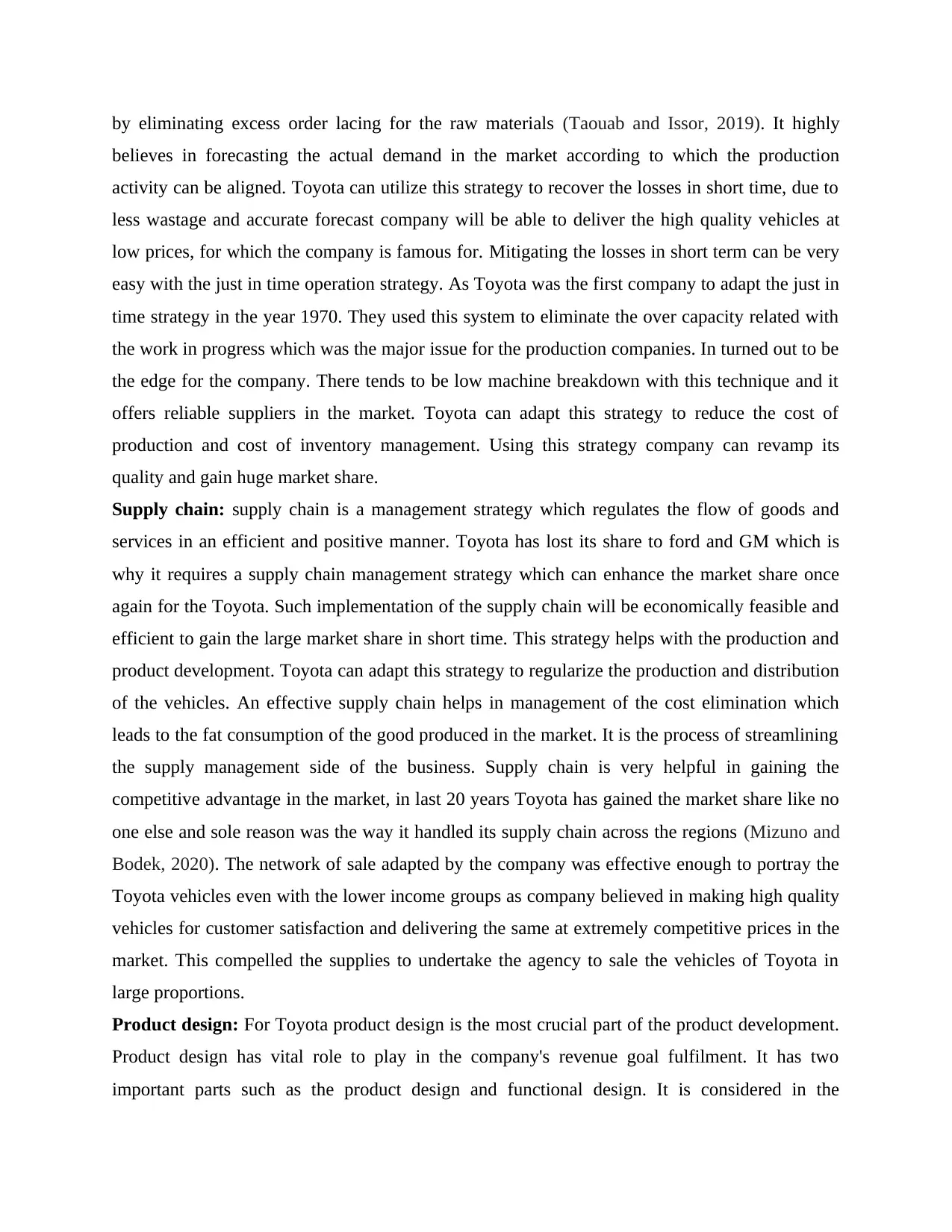
by eliminating excess order lacing for the raw materials (Taouab and Issor, 2019). It highly
believes in forecasting the actual demand in the market according to which the production
activity can be aligned. Toyota can utilize this strategy to recover the losses in short time, due to
less wastage and accurate forecast company will be able to deliver the high quality vehicles at
low prices, for which the company is famous for. Mitigating the losses in short term can be very
easy with the just in time operation strategy. As Toyota was the first company to adapt the just in
time strategy in the year 1970. They used this system to eliminate the over capacity related with
the work in progress which was the major issue for the production companies. In turned out to be
the edge for the company. There tends to be low machine breakdown with this technique and it
offers reliable suppliers in the market. Toyota can adapt this strategy to reduce the cost of
production and cost of inventory management. Using this strategy company can revamp its
quality and gain huge market share.
Supply chain: supply chain is a management strategy which regulates the flow of goods and
services in an efficient and positive manner. Toyota has lost its share to ford and GM which is
why it requires a supply chain management strategy which can enhance the market share once
again for the Toyota. Such implementation of the supply chain will be economically feasible and
efficient to gain the large market share in short time. This strategy helps with the production and
product development. Toyota can adapt this strategy to regularize the production and distribution
of the vehicles. An effective supply chain helps in management of the cost elimination which
leads to the fat consumption of the good produced in the market. It is the process of streamlining
the supply management side of the business. Supply chain is very helpful in gaining the
competitive advantage in the market, in last 20 years Toyota has gained the market share like no
one else and sole reason was the way it handled its supply chain across the regions (Mizuno and
Bodek, 2020). The network of sale adapted by the company was effective enough to portray the
Toyota vehicles even with the lower income groups as company believed in making high quality
vehicles for customer satisfaction and delivering the same at extremely competitive prices in the
market. This compelled the supplies to undertake the agency to sale the vehicles of Toyota in
large proportions.
Product design: For Toyota product design is the most crucial part of the product development.
Product design has vital role to play in the company's revenue goal fulfilment. It has two
important parts such as the product design and functional design. It is considered in the
believes in forecasting the actual demand in the market according to which the production
activity can be aligned. Toyota can utilize this strategy to recover the losses in short time, due to
less wastage and accurate forecast company will be able to deliver the high quality vehicles at
low prices, for which the company is famous for. Mitigating the losses in short term can be very
easy with the just in time operation strategy. As Toyota was the first company to adapt the just in
time strategy in the year 1970. They used this system to eliminate the over capacity related with
the work in progress which was the major issue for the production companies. In turned out to be
the edge for the company. There tends to be low machine breakdown with this technique and it
offers reliable suppliers in the market. Toyota can adapt this strategy to reduce the cost of
production and cost of inventory management. Using this strategy company can revamp its
quality and gain huge market share.
Supply chain: supply chain is a management strategy which regulates the flow of goods and
services in an efficient and positive manner. Toyota has lost its share to ford and GM which is
why it requires a supply chain management strategy which can enhance the market share once
again for the Toyota. Such implementation of the supply chain will be economically feasible and
efficient to gain the large market share in short time. This strategy helps with the production and
product development. Toyota can adapt this strategy to regularize the production and distribution
of the vehicles. An effective supply chain helps in management of the cost elimination which
leads to the fat consumption of the good produced in the market. It is the process of streamlining
the supply management side of the business. Supply chain is very helpful in gaining the
competitive advantage in the market, in last 20 years Toyota has gained the market share like no
one else and sole reason was the way it handled its supply chain across the regions (Mizuno and
Bodek, 2020). The network of sale adapted by the company was effective enough to portray the
Toyota vehicles even with the lower income groups as company believed in making high quality
vehicles for customer satisfaction and delivering the same at extremely competitive prices in the
market. This compelled the supplies to undertake the agency to sale the vehicles of Toyota in
large proportions.
Product design: For Toyota product design is the most crucial part of the product development.
Product design has vital role to play in the company's revenue goal fulfilment. It has two
important parts such as the product design and functional design. It is considered in the
Paraphrase This Document
Need a fresh take? Get an instant paraphrase of this document with our AI Paraphraser
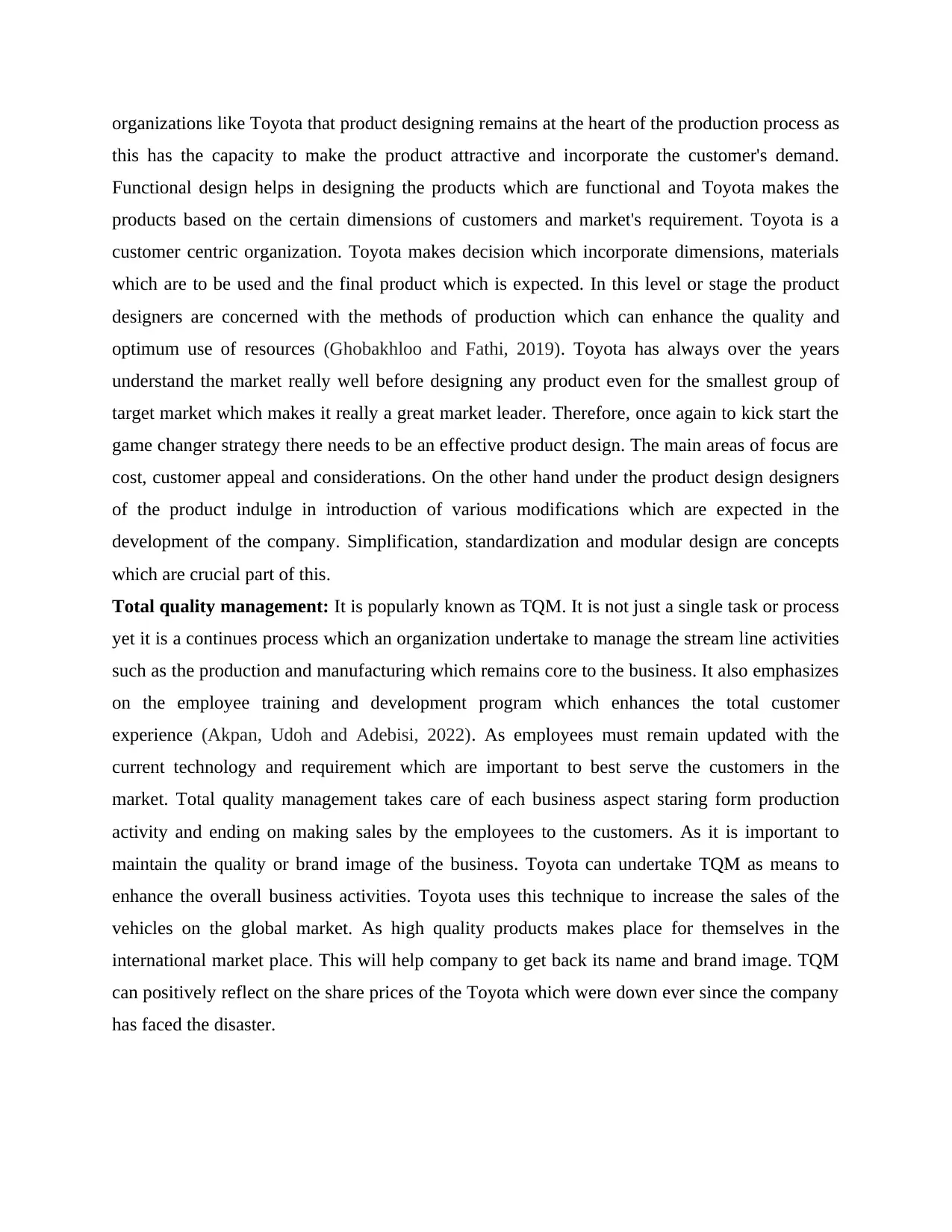
organizations like Toyota that product designing remains at the heart of the production process as
this has the capacity to make the product attractive and incorporate the customer's demand.
Functional design helps in designing the products which are functional and Toyota makes the
products based on the certain dimensions of customers and market's requirement. Toyota is a
customer centric organization. Toyota makes decision which incorporate dimensions, materials
which are to be used and the final product which is expected. In this level or stage the product
designers are concerned with the methods of production which can enhance the quality and
optimum use of resources (Ghobakhloo and Fathi, 2019). Toyota has always over the years
understand the market really well before designing any product even for the smallest group of
target market which makes it really a great market leader. Therefore, once again to kick start the
game changer strategy there needs to be an effective product design. The main areas of focus are
cost, customer appeal and considerations. On the other hand under the product design designers
of the product indulge in introduction of various modifications which are expected in the
development of the company. Simplification, standardization and modular design are concepts
which are crucial part of this.
Total quality management: It is popularly known as TQM. It is not just a single task or process
yet it is a continues process which an organization undertake to manage the stream line activities
such as the production and manufacturing which remains core to the business. It also emphasizes
on the employee training and development program which enhances the total customer
experience (Akpan, Udoh and Adebisi, 2022). As employees must remain updated with the
current technology and requirement which are important to best serve the customers in the
market. Total quality management takes care of each business aspect staring form production
activity and ending on making sales by the employees to the customers. As it is important to
maintain the quality or brand image of the business. Toyota can undertake TQM as means to
enhance the overall business activities. Toyota uses this technique to increase the sales of the
vehicles on the global market. As high quality products makes place for themselves in the
international market place. This will help company to get back its name and brand image. TQM
can positively reflect on the share prices of the Toyota which were down ever since the company
has faced the disaster.
this has the capacity to make the product attractive and incorporate the customer's demand.
Functional design helps in designing the products which are functional and Toyota makes the
products based on the certain dimensions of customers and market's requirement. Toyota is a
customer centric organization. Toyota makes decision which incorporate dimensions, materials
which are to be used and the final product which is expected. In this level or stage the product
designers are concerned with the methods of production which can enhance the quality and
optimum use of resources (Ghobakhloo and Fathi, 2019). Toyota has always over the years
understand the market really well before designing any product even for the smallest group of
target market which makes it really a great market leader. Therefore, once again to kick start the
game changer strategy there needs to be an effective product design. The main areas of focus are
cost, customer appeal and considerations. On the other hand under the product design designers
of the product indulge in introduction of various modifications which are expected in the
development of the company. Simplification, standardization and modular design are concepts
which are crucial part of this.
Total quality management: It is popularly known as TQM. It is not just a single task or process
yet it is a continues process which an organization undertake to manage the stream line activities
such as the production and manufacturing which remains core to the business. It also emphasizes
on the employee training and development program which enhances the total customer
experience (Akpan, Udoh and Adebisi, 2022). As employees must remain updated with the
current technology and requirement which are important to best serve the customers in the
market. Total quality management takes care of each business aspect staring form production
activity and ending on making sales by the employees to the customers. As it is important to
maintain the quality or brand image of the business. Toyota can undertake TQM as means to
enhance the overall business activities. Toyota uses this technique to increase the sales of the
vehicles on the global market. As high quality products makes place for themselves in the
international market place. This will help company to get back its name and brand image. TQM
can positively reflect on the share prices of the Toyota which were down ever since the company
has faced the disaster.
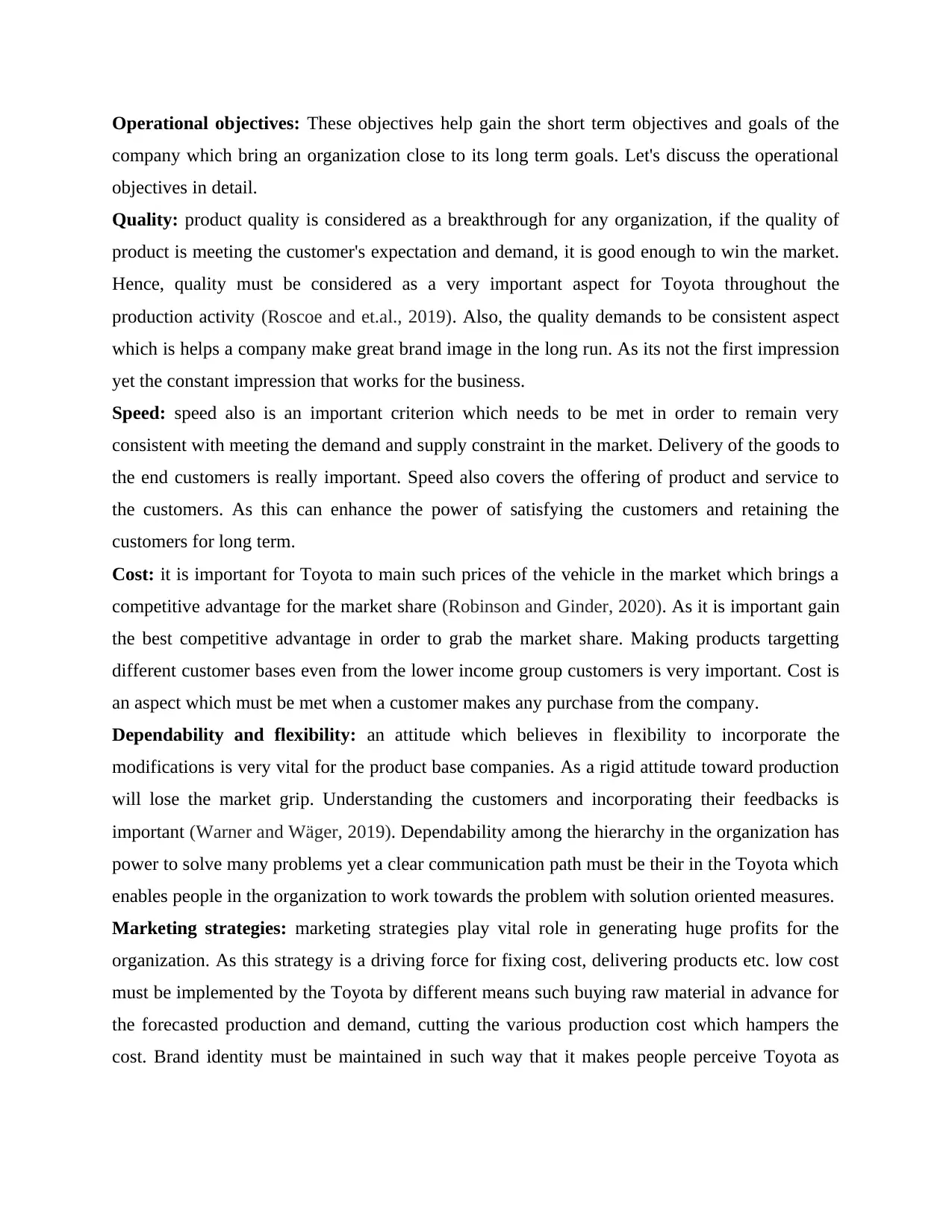
Operational objectives: These objectives help gain the short term objectives and goals of the
company which bring an organization close to its long term goals. Let's discuss the operational
objectives in detail.
Quality: product quality is considered as a breakthrough for any organization, if the quality of
product is meeting the customer's expectation and demand, it is good enough to win the market.
Hence, quality must be considered as a very important aspect for Toyota throughout the
production activity (Roscoe and et.al., 2019). Also, the quality demands to be consistent aspect
which is helps a company make great brand image in the long run. As its not the first impression
yet the constant impression that works for the business.
Speed: speed also is an important criterion which needs to be met in order to remain very
consistent with meeting the demand and supply constraint in the market. Delivery of the goods to
the end customers is really important. Speed also covers the offering of product and service to
the customers. As this can enhance the power of satisfying the customers and retaining the
customers for long term.
Cost: it is important for Toyota to main such prices of the vehicle in the market which brings a
competitive advantage for the market share (Robinson and Ginder, 2020). As it is important gain
the best competitive advantage in order to grab the market share. Making products targetting
different customer bases even from the lower income group customers is very important. Cost is
an aspect which must be met when a customer makes any purchase from the company.
Dependability and flexibility: an attitude which believes in flexibility to incorporate the
modifications is very vital for the product base companies. As a rigid attitude toward production
will lose the market grip. Understanding the customers and incorporating their feedbacks is
important (Warner and Wäger, 2019). Dependability among the hierarchy in the organization has
power to solve many problems yet a clear communication path must be their in the Toyota which
enables people in the organization to work towards the problem with solution oriented measures.
Marketing strategies: marketing strategies play vital role in generating huge profits for the
organization. As this strategy is a driving force for fixing cost, delivering products etc. low cost
must be implemented by the Toyota by different means such buying raw material in advance for
the forecasted production and demand, cutting the various production cost which hampers the
cost. Brand identity must be maintained in such way that it makes people perceive Toyota as
company which bring an organization close to its long term goals. Let's discuss the operational
objectives in detail.
Quality: product quality is considered as a breakthrough for any organization, if the quality of
product is meeting the customer's expectation and demand, it is good enough to win the market.
Hence, quality must be considered as a very important aspect for Toyota throughout the
production activity (Roscoe and et.al., 2019). Also, the quality demands to be consistent aspect
which is helps a company make great brand image in the long run. As its not the first impression
yet the constant impression that works for the business.
Speed: speed also is an important criterion which needs to be met in order to remain very
consistent with meeting the demand and supply constraint in the market. Delivery of the goods to
the end customers is really important. Speed also covers the offering of product and service to
the customers. As this can enhance the power of satisfying the customers and retaining the
customers for long term.
Cost: it is important for Toyota to main such prices of the vehicle in the market which brings a
competitive advantage for the market share (Robinson and Ginder, 2020). As it is important gain
the best competitive advantage in order to grab the market share. Making products targetting
different customer bases even from the lower income group customers is very important. Cost is
an aspect which must be met when a customer makes any purchase from the company.
Dependability and flexibility: an attitude which believes in flexibility to incorporate the
modifications is very vital for the product base companies. As a rigid attitude toward production
will lose the market grip. Understanding the customers and incorporating their feedbacks is
important (Warner and Wäger, 2019). Dependability among the hierarchy in the organization has
power to solve many problems yet a clear communication path must be their in the Toyota which
enables people in the organization to work towards the problem with solution oriented measures.
Marketing strategies: marketing strategies play vital role in generating huge profits for the
organization. As this strategy is a driving force for fixing cost, delivering products etc. low cost
must be implemented by the Toyota by different means such buying raw material in advance for
the forecasted production and demand, cutting the various production cost which hampers the
cost. Brand identity must be maintained in such way that it makes people perceive Toyota as
⊘ This is a preview!⊘
Do you want full access?
Subscribe today to unlock all pages.

Trusted by 1+ million students worldwide
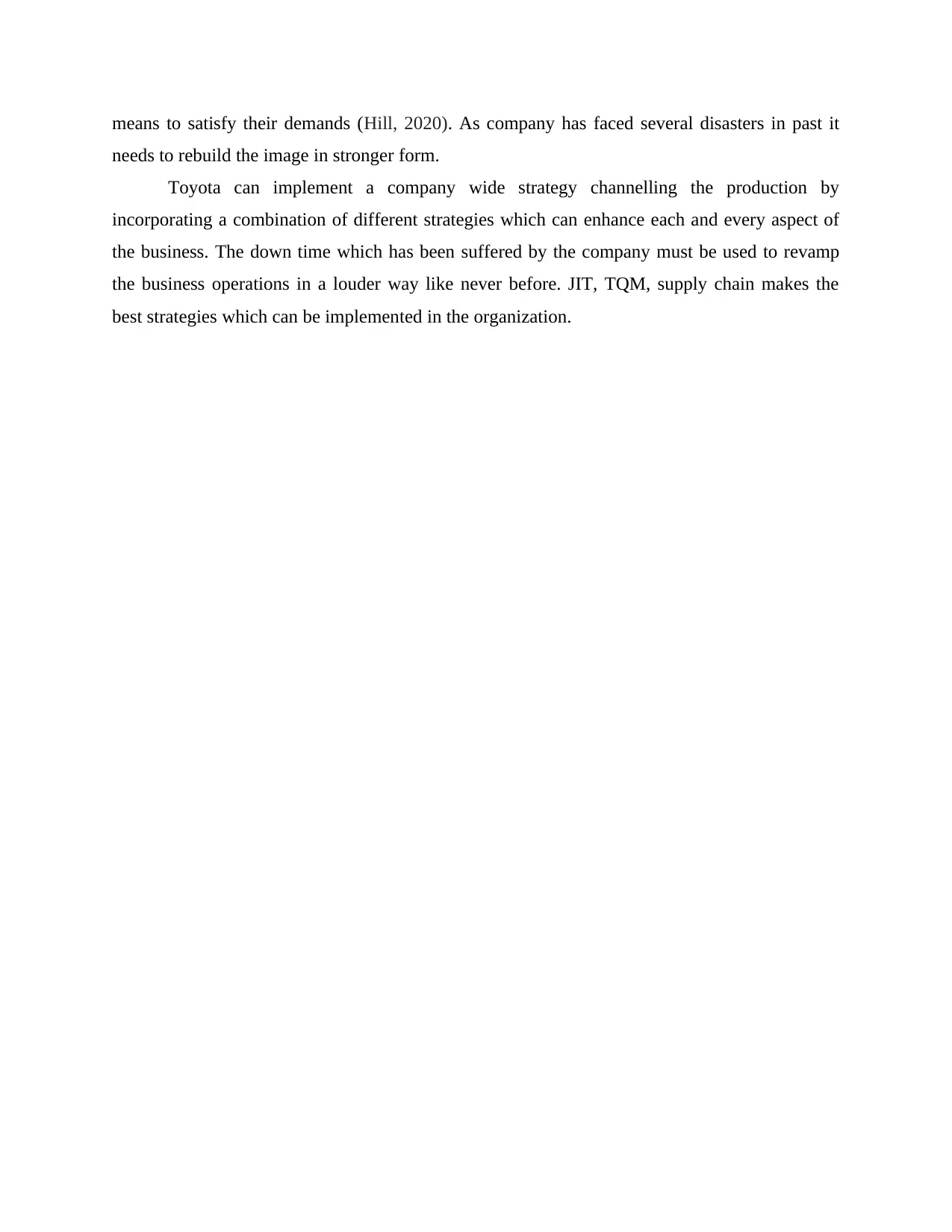
means to satisfy their demands (Hill, 2020). As company has faced several disasters in past it
needs to rebuild the image in stronger form.
Toyota can implement a company wide strategy channelling the production by
incorporating a combination of different strategies which can enhance each and every aspect of
the business. The down time which has been suffered by the company must be used to revamp
the business operations in a louder way like never before. JIT, TQM, supply chain makes the
best strategies which can be implemented in the organization.
needs to rebuild the image in stronger form.
Toyota can implement a company wide strategy channelling the production by
incorporating a combination of different strategies which can enhance each and every aspect of
the business. The down time which has been suffered by the company must be used to revamp
the business operations in a louder way like never before. JIT, TQM, supply chain makes the
best strategies which can be implemented in the organization.
Paraphrase This Document
Need a fresh take? Get an instant paraphrase of this document with our AI Paraphraser
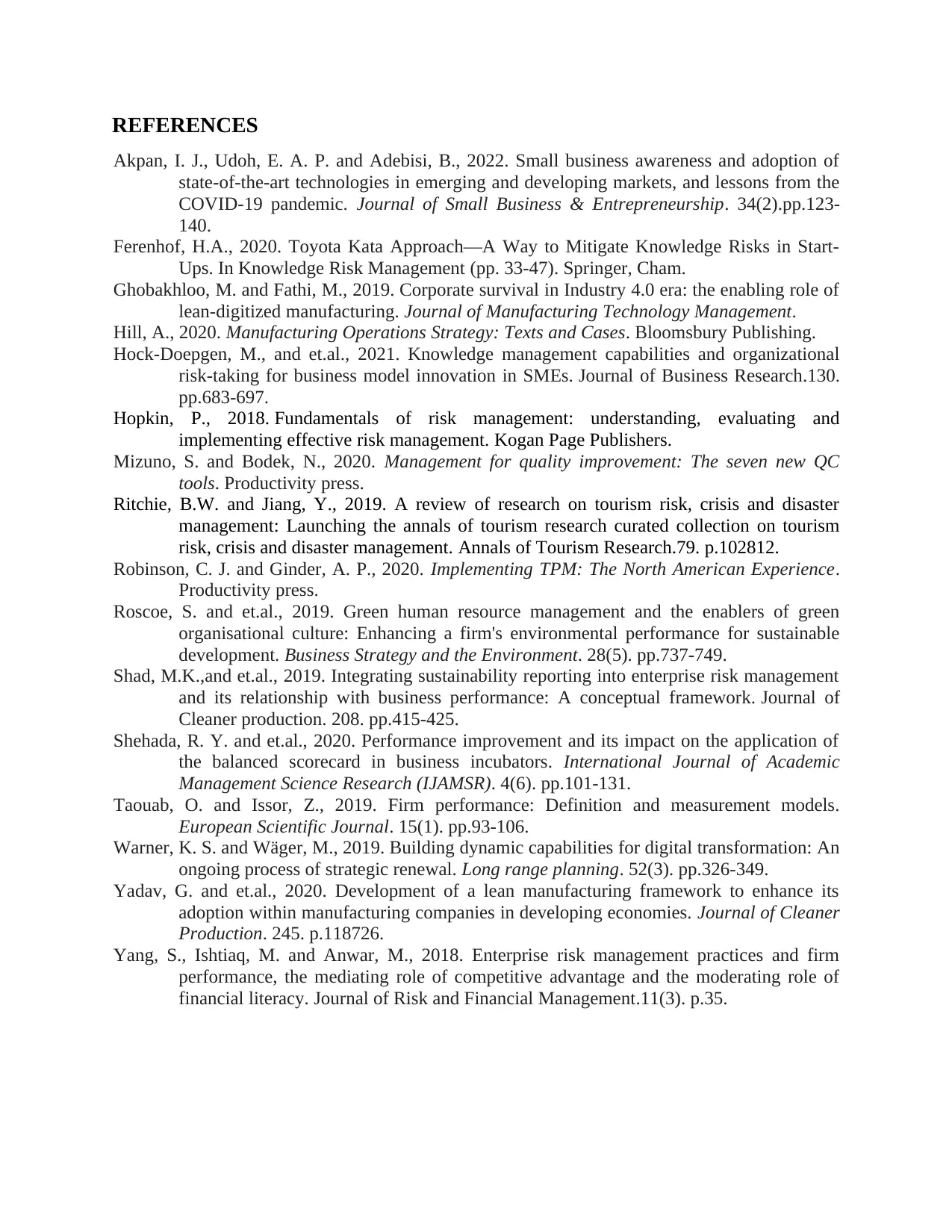
REFERENCES
Akpan, I. J., Udoh, E. A. P. and Adebisi, B., 2022. Small business awareness and adoption of
state-of-the-art technologies in emerging and developing markets, and lessons from the
COVID-19 pandemic. Journal of Small Business & Entrepreneurship. 34(2).pp.123-
140.
Ferenhof, H.A., 2020. Toyota Kata Approach—A Way to Mitigate Knowledge Risks in Start-
Ups. In Knowledge Risk Management (pp. 33-47). Springer, Cham.
Ghobakhloo, M. and Fathi, M., 2019. Corporate survival in Industry 4.0 era: the enabling role of
lean-digitized manufacturing. Journal of Manufacturing Technology Management.
Hill, A., 2020. Manufacturing Operations Strategy: Texts and Cases. Bloomsbury Publishing.
Hock-Doepgen, M., and et.al., 2021. Knowledge management capabilities and organizational
risk-taking for business model innovation in SMEs. Journal of Business Research.130.
pp.683-697.
Hopkin, P., 2018. Fundamentals of risk management: understanding, evaluating and
implementing effective risk management. Kogan Page Publishers.
Mizuno, S. and Bodek, N., 2020. Management for quality improvement: The seven new QC
tools. Productivity press.
Ritchie, B.W. and Jiang, Y., 2019. A review of research on tourism risk, crisis and disaster
management: Launching the annals of tourism research curated collection on tourism
risk, crisis and disaster management. Annals of Tourism Research.79. p.102812.
Robinson, C. J. and Ginder, A. P., 2020. Implementing TPM: The North American Experience.
Productivity press.
Roscoe, S. and et.al., 2019. Green human resource management and the enablers of green
organisational culture: Enhancing a firm's environmental performance for sustainable
development. Business Strategy and the Environment. 28(5). pp.737-749.
Shad, M.K.,and et.al., 2019. Integrating sustainability reporting into enterprise risk management
and its relationship with business performance: A conceptual framework. Journal of
Cleaner production. 208. pp.415-425.
Shehada, R. Y. and et.al., 2020. Performance improvement and its impact on the application of
the balanced scorecard in business incubators. International Journal of Academic
Management Science Research (IJAMSR). 4(6). pp.101-131.
Taouab, O. and Issor, Z., 2019. Firm performance: Definition and measurement models.
European Scientific Journal. 15(1). pp.93-106.
Warner, K. S. and Wäger, M., 2019. Building dynamic capabilities for digital transformation: An
ongoing process of strategic renewal. Long range planning. 52(3). pp.326-349.
Yadav, G. and et.al., 2020. Development of a lean manufacturing framework to enhance its
adoption within manufacturing companies in developing economies. Journal of Cleaner
Production. 245. p.118726.
Yang, S., Ishtiaq, M. and Anwar, M., 2018. Enterprise risk management practices and firm
performance, the mediating role of competitive advantage and the moderating role of
financial literacy. Journal of Risk and Financial Management.11(3). p.35.
Akpan, I. J., Udoh, E. A. P. and Adebisi, B., 2022. Small business awareness and adoption of
state-of-the-art technologies in emerging and developing markets, and lessons from the
COVID-19 pandemic. Journal of Small Business & Entrepreneurship. 34(2).pp.123-
140.
Ferenhof, H.A., 2020. Toyota Kata Approach—A Way to Mitigate Knowledge Risks in Start-
Ups. In Knowledge Risk Management (pp. 33-47). Springer, Cham.
Ghobakhloo, M. and Fathi, M., 2019. Corporate survival in Industry 4.0 era: the enabling role of
lean-digitized manufacturing. Journal of Manufacturing Technology Management.
Hill, A., 2020. Manufacturing Operations Strategy: Texts and Cases. Bloomsbury Publishing.
Hock-Doepgen, M., and et.al., 2021. Knowledge management capabilities and organizational
risk-taking for business model innovation in SMEs. Journal of Business Research.130.
pp.683-697.
Hopkin, P., 2018. Fundamentals of risk management: understanding, evaluating and
implementing effective risk management. Kogan Page Publishers.
Mizuno, S. and Bodek, N., 2020. Management for quality improvement: The seven new QC
tools. Productivity press.
Ritchie, B.W. and Jiang, Y., 2019. A review of research on tourism risk, crisis and disaster
management: Launching the annals of tourism research curated collection on tourism
risk, crisis and disaster management. Annals of Tourism Research.79. p.102812.
Robinson, C. J. and Ginder, A. P., 2020. Implementing TPM: The North American Experience.
Productivity press.
Roscoe, S. and et.al., 2019. Green human resource management and the enablers of green
organisational culture: Enhancing a firm's environmental performance for sustainable
development. Business Strategy and the Environment. 28(5). pp.737-749.
Shad, M.K.,and et.al., 2019. Integrating sustainability reporting into enterprise risk management
and its relationship with business performance: A conceptual framework. Journal of
Cleaner production. 208. pp.415-425.
Shehada, R. Y. and et.al., 2020. Performance improvement and its impact on the application of
the balanced scorecard in business incubators. International Journal of Academic
Management Science Research (IJAMSR). 4(6). pp.101-131.
Taouab, O. and Issor, Z., 2019. Firm performance: Definition and measurement models.
European Scientific Journal. 15(1). pp.93-106.
Warner, K. S. and Wäger, M., 2019. Building dynamic capabilities for digital transformation: An
ongoing process of strategic renewal. Long range planning. 52(3). pp.326-349.
Yadav, G. and et.al., 2020. Development of a lean manufacturing framework to enhance its
adoption within manufacturing companies in developing economies. Journal of Cleaner
Production. 245. p.118726.
Yang, S., Ishtiaq, M. and Anwar, M., 2018. Enterprise risk management practices and firm
performance, the mediating role of competitive advantage and the moderating role of
financial literacy. Journal of Risk and Financial Management.11(3). p.35.
1 out of 11
Related Documents
Your All-in-One AI-Powered Toolkit for Academic Success.
+13062052269
info@desklib.com
Available 24*7 on WhatsApp / Email
![[object Object]](/_next/static/media/star-bottom.7253800d.svg)
Unlock your academic potential
Copyright © 2020–2025 A2Z Services. All Rights Reserved. Developed and managed by ZUCOL.





